By: Rob Mulder
For: www.europeanairlines.no
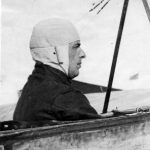 In 1912 the Swedish aviator Olle Dahlbeck came to Kristiania (now Oslo) to fly with his monoplane the Sommer F and his biplane the Bristol Boxkite for an enthusiastic Norwegian audience. He made several flights, among them the first flight in Norway with a female passenger. And Norway had another novelty: His monoplane Sommer F made its first flights in Norway!
In 1912 the Swedish aviator Olle Dahlbeck came to Kristiania (now Oslo) to fly with his monoplane the Sommer F and his biplane the Bristol Boxkite for an enthusiastic Norwegian audience. He made several flights, among them the first flight in Norway with a female passenger. And Norway had another novelty: His monoplane Sommer F made its first flights in Norway!
On 14 October 1910, the Swedish baron Carl Cederström made the first flight in Norway of a heavier-than-air craft. In 2010 this event was only marked with little attention. The big celebration will be in 2012, when it is 100 years ago that the Norwegian lieutenant Dons made the first flight of a Norwegian in a heavier-than-air craft. Between 1910 and 1912 Swedes dominated the Norwegian sky, but in the middle of April 1912 newspapers brought out the news that the spring of 1912 was to be marked with flights of several aircraft Norway. And this time by Norwegians.
First of all, the young engineer Christian Lie said he wanted to become the first Norwegian to fly a heavier-than-air craft. He had studied aviation in both France and Germany. He had formed a small partnership with Hallfred Sjølie, Kaare Sjølie, Olaf Mykleby and Karl Øvergaard (all from the village of Rendalen). They had gathered 11,000 Norwegian kroner and for this money they would purchase a Grade-aircraft and get Lie trained. The aircraft had a 30 hp engine and a maximum speed of 100 kph. He expected to return with the aircraft to Norway at the end of May. After that he wanted to make several flights near Norwegian towns.
Secondly, the French aviator Poulain had plans to come to Norway and fly out of Kristiania with a seaplane. He wanted to work together with a newly found company under the name of “Det Norske Flyveselskab A/S. This company was officially formed on 14 May 1912 and was to organize joy- and demonstration flights. It wanted to purchase a Deperdussin and engaged the Norwegian Jul Hansen as pilot. Hansen was to travel down to France for training.
Finally, the Norsk Luftseiladsforeningen (the Norwegian Aero Club of the time) announced that Captain Dahlbeck from Sweden had announced his arrival and he would like to “bomb” the Norwegian naval harbour at Horten with oranges. This sparked off an initiative of some Norwegian naval officers, who started to collect money for the purchase of an aircraft and the training of one of their men, lieutenant Dons. This resulted in the purchasing of Etrich-Taube and the training of the lieutenant in Germany. On 1 June 1912 he was to be the first Norwegian citizen to make a flight in Norway in a heavier-than-air craft. The machine was baptized “Start”.
Disbelieve from the Norwegians
The announcement of the bombardment was met with disbelieve and Dahlbeck therefore decided to drop the flight. But he came to Norway. His first aircraft was already expected on 15 April, but this was delayed. Dahlbeck owned a small company by the name of Flygaktiebolaget Dahlbeck, where Mr. Prytz was the general manager. It had purchased two aircraft: the monoplane Sommer F (Type S-13) and the biplane Bristol Boxkite. And now both were to come to Kristiania around 11-12 May.
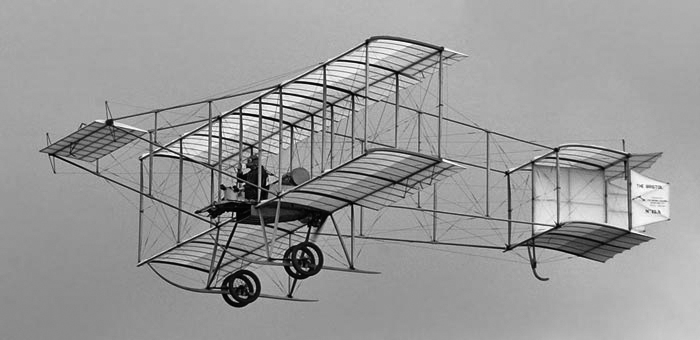
On 9 May the Bristol Boxkite had arrived from Jönköping and had been take to an area near Kristiania, called Etterstad. This was chosen in favor of the military camp of Gardermoen, outside the town. To assist Dahlbeck, the Norwegian balloonist Francesco Cetti and Jul Hansen would assist the Swedish aviator. Furthermore Swedish personnel were to join Dahlbeck, including a clerk, a timber man and some assistants. Also the Swedish engineer Schiller came to Kristiania and assisted with the construction of a hangar at Etterstad. They hoped to start joy- and demonstration flights in the weekend of 10-12 May. Unfortunately Lieutenant Dahlbeck was delayed and did not come until Monday 13 May. Furthermore, the Sommer F had been sent to Italy instead of Sweden, thus there was a delay of the arrival of this little monoplane. Instead of sending the aircraft to Linköping/Malmslätt it was decided to transport it directly to Norway. The Norwegians were to be the first audience in Scandinavia to see this monoplane fly.
Meanwhile, the chief of police Mr. Fürst and the local police man Wetlesen had inspected and approved the premises at Etterstad. Dahlbeck would have about 100-120 meters space for takeoff and landing. Well enough. The police would come with up to 125 men to control the expected crowd. The biplane was still under construction, while the Sommer F had been returned from Italy to Germany and was on Friday 10 May shipped from Hamburg directly to Kristiania.
Dahlbeck welcomed
Lieutenant Dahlbeck had by now arrived in Kristiania. On 14 May at 12 noon he was received in audience at the Royal Palace at King Haakon VII. And in the evening the Norsk Luftseiladsforeningen offered him a supper at the Restaurant Dronningen (the Queen). Among the speakers that evening was the chairman of the military committee at the Parliament, Lieutenant-Colonel Aavatsmark and the newly elected chairman of the aero club, Thomas Heftye.
Many were interested in a joyflight with Dahlbeck in the Bristol Boxkite. The first female passenger to fly in Norway was photographed in front of the Bristol Boxkite: Miss Kirsten Lampe was to be the first, but was not allowed to do so by her boss, director Otto. She was quite disappointed.
On 15 May the Bristol Boxkite had been taken out of the hangar and the engine was tested. Eight men had to held back the aircraft and stop it from taking off. The flights for the audience and with passengers had to be postponed. Out of respect of the sudden death of the Danish King Frederik VIII all public flying was stopped. King Frederik VIII was the farther of King Haakon VII of Norway.
But at the end of the day lieutenant Dahlbeck found it advisable to make some test flights with the biplane. Around 20.00 hrs he took off and made a short flight above Kristiania. After five minutes he returned and made a smooth landing on the grass of the Etterstad field. Dahlbeck expressed that the engine functioned perfectly, better than ever. It only needed a few adjustments and a new propeller had to be mounted before the flights could start. The tram carriages in Kristiania would drive with red flags if the flights would take place on 16 May. That evening the Sommer F monoplane arrived by train from Hamburg and was taken to Hengsenga on the peninsula of Bygdøy (Kristiania) for assembly.
Finally flying!
The flying on this Ascension Day (16 May) had started at 4 am when an automobile drove up to the hangar at high speeds and out of this car came seven persons, among them Lieutenant Dahlbeck. The Bristol Boxkite was taken out and the engine was started. He took off and made a five-minute flight above Kristiania. The sun had but just risen. The biplane landed on the Etterstad field and was rolled back into the hangar. The front cover of the hangar was closed and within ten minutes the party jumped back in the automobile and disappeared back to the centre of Kristiania.
Later that morning the tram carriages and the taxi drivers (who had just returned from a strike) carried a red flag, which meant that lieutenant Dahlbeck would attempt to fly at 18.00 hrs. Well before the start of the event, people were walking towards the Etterstad field. Those who could afford it took the tram carriage and/or taxis, while special trucks were converted with benches and used as bus. At the Etterstad field the audience could chose between three different seats: the best seats near the hangar would cost 2 kroner, further out 1 krone and the worst seats would cost 50 øre. There were also numerous free seats. At 18.00 hrs some five hundred people had taken seats at the 2-kroner seats, while another 1,000 at the 1-krone seats and some 1,500 at the cheapest seats. But these numbers soon doubled and including the free seats the police believed that some 15,000 people had come. The Norwegian and Swedish flags flew beside each other and the open air restaurant was doing good business.
At the southeast corner of the field had the hangar been erected, just a some hundred meters from the railway track. The view from the field towards the fjord was spectacular and the clear blue water and the sun behind the small clouds made it a perfect evening for flying. The wind was nearly gone. Jul Hansen joined in checking the aircraft before the first take-off. Among the audience were members of the Government: Minister Stang, Minister Brænne, Minister Irgens, Minister Konow and Minister Liljedahl. Also the Major General Bull and a lot of other officers had come to Etterstad. The Swedish ambassador, Mr. Aspelin and other members of the Swedish population in Kristiania came to see their countryman fly. Nearby were also the balloonist Cetti, Engineer Schiller and the brother of the lieutenant. At 18.00 hrs Lieutenant Dahlbeck entered the field in his automobile and was cheered by the crowd.
The Bristol Boxkite was taken out of the hangar and the engine was started. Dahlbeck went into the hangar and changed into his flying suite, smoked a cigarette, came out and climbed into his aircraft at 18.40 hrs. Ten officers held back the aircraft and at Dahlbecks command “lachez tout!” (release everything) they all let go of the aircraft. Within 80-100 meters the aircraft was in the air. It flew in the direction of the fjord and went up to 100 meters. He made a swing to the left and returned from the southern part of the field. The audience cheered and waved their handkerchiefs. Dahlbeck waved back. The flight went smooth and safe. The newspaper wrote: “Finally flying! And a brilliant flight it was. Not too long – two flight of respectively five and eight minutes. And lieutenant Dahlbeck was on both occasions alone in the Bristol-biplane. But the flight was done in such a safe and elegant way, especially the gliding during the landing and the landing itself, were noticed by the audience and gave a perfect impression of the skills of the Swedish aviator. It was a definitive prove that we also here in the north (of Europe) have past the first trial period of flight. More safely as Dahlbeck flew is not possible”.
(If you want to experience how people at Etterstad experience the flight of the Bristol Boxkite have a look at the words: BRISTOL BOXKITE
He continued by making a large curve and climbing to 200 meters flying across the Brynsgaard Farm, across the chemical plant “Norden” and towards the Østre Aker Church. He crossed the Gulhaug Farm, the Solvang Farm, the Helsfyr Farm and even the old Etterstad Farm and made a new curve now towards the Vålerenga Church and Etterstad. Just before the landing Dahlbeck stopped his engine and glided and sat down the Bristol Boxkite smoothly on the field. The audience was in ecstasy and shouted “Long Live Sweden!”.
The flight that day was to be followed by a flight with passengers, but Dahlbeck noticed a leak in the oil pipes and of that reason did not want to take anyone in the air. After 15 minutes he took off again for a second flight where he reached a height of 400 meters and stayed eight minutes in the air. Of course the audience was disappointed, but understood his decision not to take up any passengers. New flights were scheduled for Saturday evening at 18.00 hrs.
During the check up of the engine they found that one of cylinders had run warm and once the engine had been taken from each other, they found several small leaks. The engine was repaired and on Saturday 18 May, Dahlbeck was able to take off again.
On 17 May (Norway’s National Holiday) Dahlbeck was again in the air, but this in the balloon “Norge” (Norway) of balloonist Francesco Cetti. Captain Sem-Jakobsen was in command of the flight and they were joined by Stephanson.
But also on Saturday, 18 May it was not possible for Lieutenant Dahlbeck to carry any passengers in the air. The reason was the sudden change in the weather. It became overcast and the wind gained strength and spoiled the party at Etterstad. In addition it started to rain. He made a short flight before the bad weather started. The take-off went fine and he came in the air after just 20-30 meters. At the end of the field he turned to the left towards Brynsberg Farm and Østre Akers Church. He reached a height of 120 meters. After passing the church tower of the Vålerenga Church the Bristol Boxkite suddenly descended rapidly and disappeared out of sight. It did not crash, because the engine was still running. But of course the audience was afraid something bad had happened. Several of his assistants jumped into a car and wanted to drive to the crash site, but suddenly the Bristol Boxkite gained height again and climbed to 50 meters. It took a turn towards Etterstad field. Upon the landing one could see that something was wrong with the engine, but it managed to get down and stop just 20 meters in front of the hangar. He was cheered by the crowd, who was glad to see that he was OK. The reason for his rapid descent was that he was forced down by strong winds and that the engine started to protest. He had landed at a potato field of the Valle Farm, but as his engine functioned fine again, he decided to take off again. Near the Etterstad field new engine problems occurred and a rough landing was the result. Since it had started to rain, the aircraft was pulled into the hangar and all flying that Saturday evening were discontinued. A new attempt was to be made the next day.
The first flight of the Sommer F
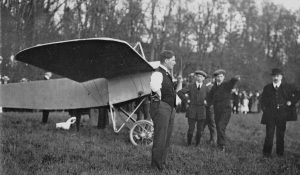 On Saturday Lieutenant Dahlbeck had announced that on Sunday he would fly the new monoplane Sommer F (S-13) from Bygdøy to Etterstad for demonstration flights. Normally, a new aircraft like this has to be tested before a longer flight was made. And furthermore, Lieutenant Dahlbeck had never flown this aircraft before, so everything was new to him. Earlier he had flown monoplanes of the type Blériot, but they did not have the same speed (160 kph) as the Sommer F. But he wanted to fly the aircraft for the population of Kristiania. The aircraft had been in the early hours of Sunday been taken to the Bygdø Kongsgaard (the King’s Farm at Bygdøy) and had been put together under supervision of Lieutenant Dahlbeck. In the late afternoon the monoplane was ready for its first flight and Dahlbeck just made some small jumps and movements with the stick to see how it responded. At 19.00 hrs he could not wait any longer and took the bold decision to fly the aircraft directly to Etterstad. A large crowd had gathered there already. The weather was nice and the sky was clear. The audience was informed that Dahlbeck was to come with his monoplane from Bygdøy.
On Saturday Lieutenant Dahlbeck had announced that on Sunday he would fly the new monoplane Sommer F (S-13) from Bygdøy to Etterstad for demonstration flights. Normally, a new aircraft like this has to be tested before a longer flight was made. And furthermore, Lieutenant Dahlbeck had never flown this aircraft before, so everything was new to him. Earlier he had flown monoplanes of the type Blériot, but they did not have the same speed (160 kph) as the Sommer F. But he wanted to fly the aircraft for the population of Kristiania. The aircraft had been in the early hours of Sunday been taken to the Bygdø Kongsgaard (the King’s Farm at Bygdøy) and had been put together under supervision of Lieutenant Dahlbeck. In the late afternoon the monoplane was ready for its first flight and Dahlbeck just made some small jumps and movements with the stick to see how it responded. At 19.00 hrs he could not wait any longer and took the bold decision to fly the aircraft directly to Etterstad. A large crowd had gathered there already. The weather was nice and the sky was clear. The audience was informed that Dahlbeck was to come with his monoplane from Bygdøy.
At Etterstad a big sail was ready to stop the aircraft in case it had a too high speed and could not stop in time. At 19.30 hrs he called and said he was to take-off and everybody looked in the direction of Bygdøy to see if he came. He took off at 19.30 hrs and climbed rapidly to a height of 1,200 meters! The audience could see the small dot in the air getting closer and more and more the shape of the monoplane was visible. Halfway above the fjord he turned towards Etterstad and started to descend. After four minutes he was above Etterstad and at a height of 750 meters. The audience started to cheer and enjoyed the beautiful sight. Everything looked fine. He made a turn around the Østre Aker Church and started a fast descend and landed at the quarter of Sinsen. The oil holder had been overfilled and oil was leaking out. This was repaired by Mr. Schou and his chauffeur. Lieutenant Dahlbeck started the engine again, jumped in the cockpit of the monoplane and took off again. He made a gallant landing at the Etterstad field and wanted to drive all the way to the hangar. He turned on the engine again. On his way to the hangar one of the wheel got into a pit and before he knew it the monoplane stood on its nose. The propeller broke off and flies along Dahlbeck missing him by some inches. Dahlbeck managed to get out of the aircraft that by now had falling on its back. Since he was OK, he was taken on the shoulders of the audience and taken to the hangar. The aircraft was taken apart and 25 men carried the bits to the hangar to put it together again. It would take 3-4 days to put the aircraft together again.
The next day, Lieutenant Dahlbeck visited the workshop of the Kristiania Elektriske Sporvei (the Christiania Electrical Railroad) to have a look at the Blériot his friend Jul Hansen was building and that basically only lacked an engine and cloth on the wings. He planned to use it for training and perhaps even start a flying school.
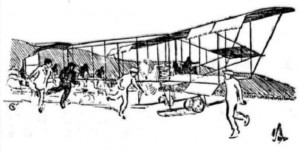
After a few days of silence the Bristol Boxkite was ready for flying again on Thursday. That evening at 20.30 hrs he came to the Etterstad field and flew a few hours short flights, first alone and then with passengers, one at the time. The first flight took him 7-8 minutes and he landed at the Høvind Farm of the farmer Fraas. Several hundred people gathered around Lieutenant Dahlbeck and from the crowd he invited a small boy for a free ride in his Bristol Boxkite. After some small repairs, he approached a small group of young ladies and invited one of them, Miss Sigrid Ingebrigtsen (daughter of factory owner and whale ship owner Morten A. Ingebrigtsen) to make a flight with him across the field and back to Etterstad. They flew in a height of 150 meters, and the Bristol Boxkite was parked in front of the hangar on the field. Ms Ingebrigtsen was now the first Norwegian woman recorded to have flown as a passenger in a heavier-than-air craft. The flight lasted for 8-9 minutes. She was cheered by the crowd and expressed that she found it “merveilleux!!”. She had witnessed several flights in Nizza and Paris and had always had the urge to fly along. She said: “The aircraft did not shake at all. It was fun, but a little bit cold as well… next time I will put on more cloths”.
The next day, Friday 24 May, at 19.30 hrs things were starting to happen again. Again flights were made with passengers in the Bristol Boxkite. Again he went down again on the fields of the Høvind Farm of the farmer Fraas. The farmers were not too happy with these landings as a crowd always gathered around the aircraft destroying the harvest. Also this time. Just one short flight with the editor O. W. Erichsen, who became the third passenger to have flown in the Bristol Boxkite. No more spectators were interested in a flight also because the weather was getting bad. It was overcast and the wind increased. Because of darkness, Lieutenant Dahlbeck had to return to Etterstad Field quickly. During his flight back he was forced down twice, once because of lack of petrol. It was not until well after 22.00 hrs that the Bristol Boxkite could return to the field. Jul Hansen had lighted a fire at the edge of the field to mark the spot where Lieutenant Dahlbeck had to put down his aircraft. At 22.20 hrs the engine could be heard and before the audience knew it the Bristol Boxkite had made a perfect touchdown. Again he was lifted out of the aircraft and carried by the impressed crowd to the hangar.
This flight was to be the last flight in Kristiania. He would now move the monoplane Sommer F (S-13) down to Drammen (some forty kilometers southwest of Kristiania), where the next demonstration flights were scheduled.
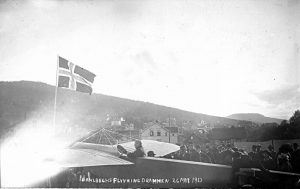 On 26 May, White Sunday, Lieutenant Dahlbeck had come to Huseby near Drammen. A large crowd had gathered again to see the monoplane fly. There was a strong wind and it rained occasionally. Lieutenant Dahlbeck took-off and climbed to 500 meters. Here he was caught by a wind gust, but he managed to get control over the aircraft again. The subsequent landing went without any problems. The bad weather made any further flying impossible and the scheduled flights in Drammen were cancelled.
On 26 May, White Sunday, Lieutenant Dahlbeck had come to Huseby near Drammen. A large crowd had gathered again to see the monoplane fly. There was a strong wind and it rained occasionally. Lieutenant Dahlbeck took-off and climbed to 500 meters. Here he was caught by a wind gust, but he managed to get control over the aircraft again. The subsequent landing went without any problems. The bad weather made any further flying impossible and the scheduled flights in Drammen were cancelled.
Flights were scheduled in Bergen and Fredrikstad as well, but did not take place. From Norway he proceeded to Denmark for demonstration flights there. The visit to Norway had been concluded.
